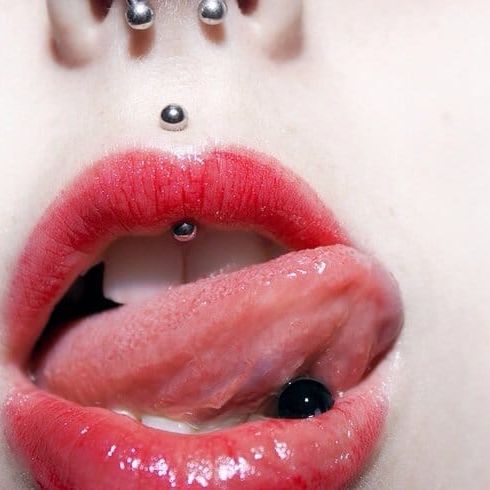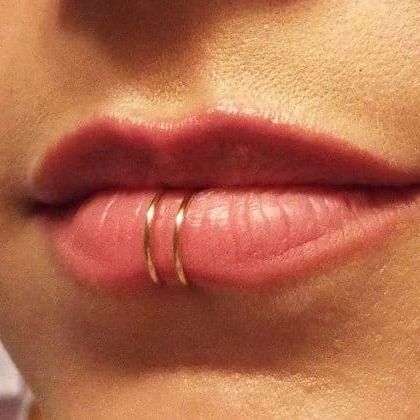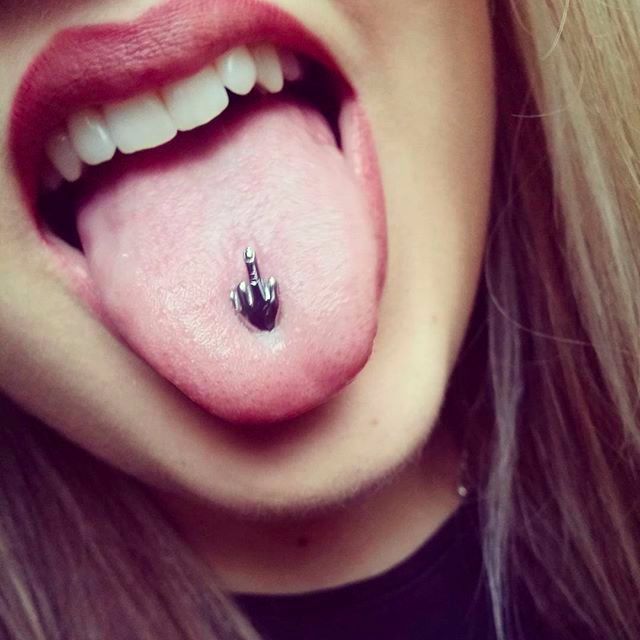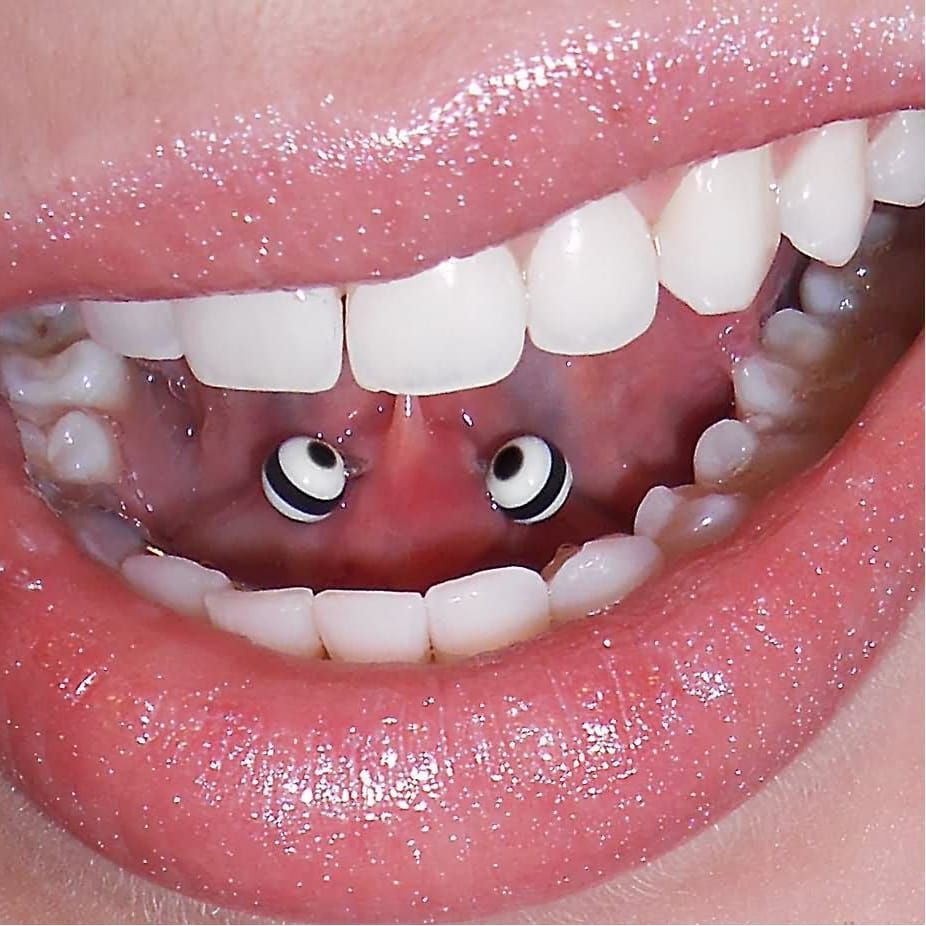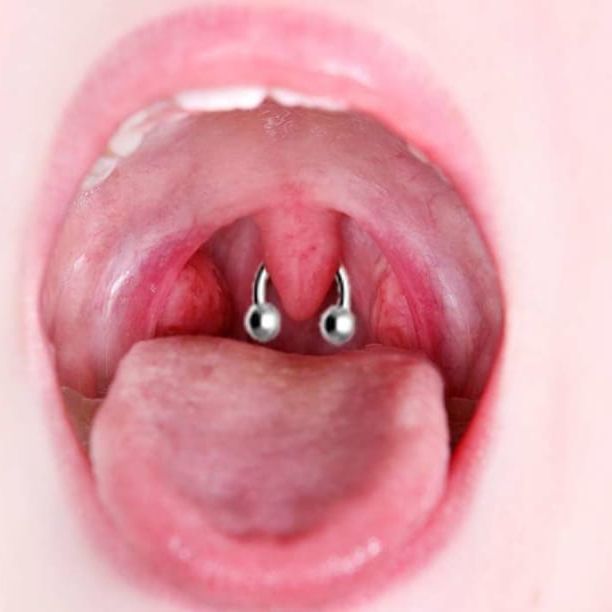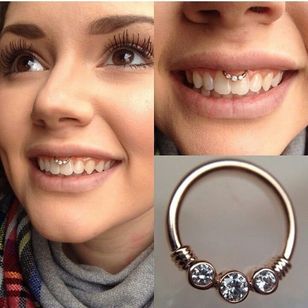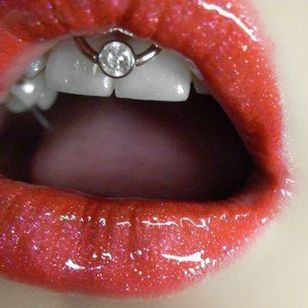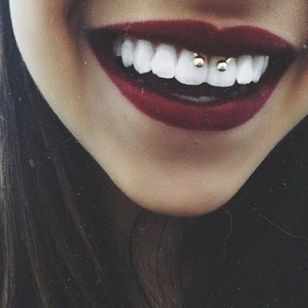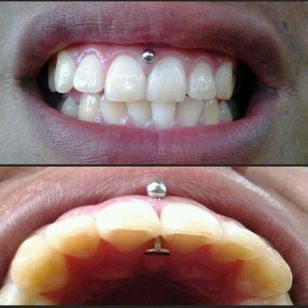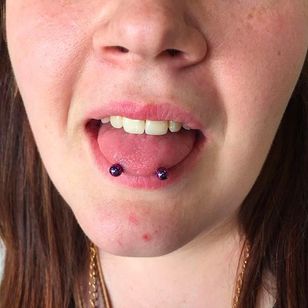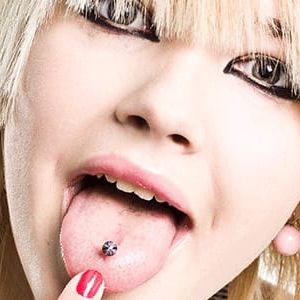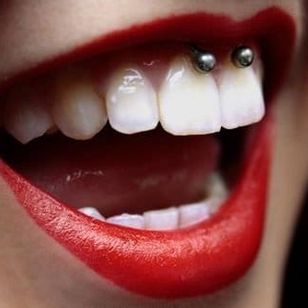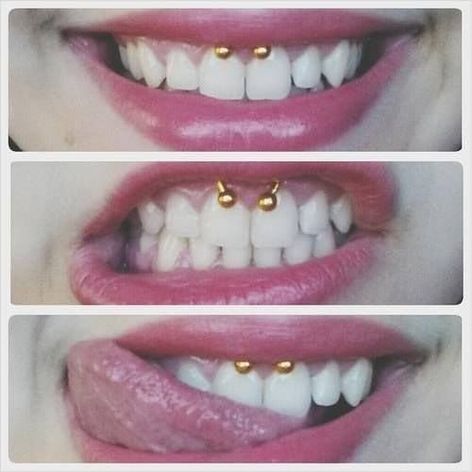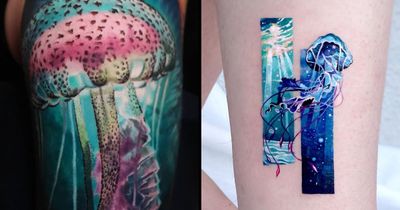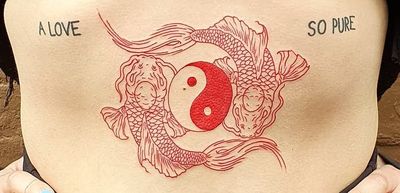Mini Guide: Types of Oral Piercings
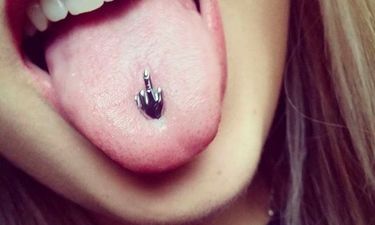
Summary
Learn the names of your favorite oral piercings with this mini guide.
A fun and comprehensive guide to oral piercings filling you in on all you need to know about the piercing process, aesthetic options and aftercare. Read on to check learn more about the various types of mouth piercings while gaining inspiration!
1. TYPES OF LIP PIERCINGS
Bottom Lip Piercing - Labret
The labret lip piercing is one of the most popular choices for bottom lip piercings. The labret is defined as a horizontal piercing placed beneath the center or side of the bottom lip.
Swelling is common within the first 1-2 weeks of healing with this type of piercing. To combat discomfort during the initial healing process your piercer will use a larger sized piece of jewelry to provide extra space. After approximately 3-4 weeks of healing you can safely switch to a smaller flat back barbell or threadless labret post in sizes 14 or 16 gauge.
Left Upper Lip Piercing - Monroe
The Monroe piercing’s name hails from the pop-culture icon, Marilyn Monroe. The piercing, which is done above the left side of the upper lip, is meant to mimic her famous beauty mark. This piercing is commonly achieved using a 16 gauge flat back barbell.
Pain levels are usually pretty low for this type of piercing, but healing can be arduous if not properly cleaned and cared for. Typical healing time for a Monroe piercing is around 6-10 weeks, up to 9 months.
Center Upper Lip Piercing - Medusa
Commonly referred to as the “medusa” or philtrum piercing, this unique adornment is placed above the center of the upper lip in the indented groove known as the “philtrum”. If you are looking for a truly unique mouth piercing the medusa is an excellent choice.
Typically pierced with a 16 gauge hollow needle, this piercing works best with a flat back barbell or pushpin labret post. Typical healing takes place within 6-12 weeks.
Center Vertical Bottom Lip Piercing - Vertical Labret
A sexy and fun piercing that can work to accentuate your pout, this variation of the traditional labret is vertically placed, allowing both ends of the jewelry to be showcased. This piercing is an excellent option for those who don’t want to risk damage to the teeth or gums, since the actual jewelry never touches the inside of the mouth. The particular placement also allows for an easier healing process due to its positioning outside of the mouth. This look is commonly achieved by using a 16 gauge curved barbell.
Double Piercing on Far Sides of Lower Lip - Snake Bites
The snake bite piercing is traditionally done by creating two separate punctures on the far sides of the mouth, beneath the lower lip. This type of lip piercing can be a bit more complicated during healing than others, due to the fact that it requires two separate puncture wounds.
Prior to the procedure your experienced piercer will mark the area with washable marker, so you can ensure that both sides are lined up evenly. This dual piercing does cause more stress to the body, so it is important to keep the areas clean throughout the healing process which is typically 6-8 weeks.
The most highly recommended jewelry for this style are captive rings, circular barbells or labret studs in 14 or 16 gauge.
Piercing Through Center of the Lip - Inverted Vertical Labret
The inverted vertical labret, also known as the “Ashley” piercing, is one of the few lip piercings that actually travels through the lip itself. This piercing is done with a single puncture through the lip, exiting out the back of the lip inside the mouth.
When choosing a piece of jewelry for this piercing it is recommended to use a 16 gauge flat back labret stud to help minimize contact with the teeth. You will want to make sure that the jewelry does not push too far back into the mouth, as this can cause painful tooth chipping and damage to the gums.
Healing time is extended a bit longer than traditional lip piercings and usually takes around 4 months.
Center Vertical Upper Lip Piercing - Jestrum
Also known as the vertical medusa or vertical philtrum, the jestrum piercing is a fun and unique center lip piercing. This vertical piercing enters through the philtrum, or indent above the upper lip, and exits from the center of the top lip, allowing both sides of the jewelry to be visible.
Although this particular piercing is not considered to rank high on the pain scale, it does have a lengthy healing time. Typically it will take between 6-12 weeks for the exterior to heal, and up to 6 months for the interior.
It is recommended to use a 16 gauge barbell for this type of lip piercing.
Double Piercing on Same Side of Lower Lip - Spider Bites
The spider bite piercing is done by creating two punctures in close proximity to another on the same side of the lower lip, but can also be done on the upper lip as well. Placement is highly important with this type of side lip piercing. You’ll want to work with your professional piercer to ensure that there is the right amount of distance between the holes, creating the effect of an actual spider bite.
This piercing on average takes about 1-3 months to heal. During the healing process it is highly important to practice good dental hygiene.
The most popular jewelry choices for this dual piercing are captive rings, labret studs and circular barbells.
Piercing above Right Side of Upper Lip - Madonna
If you are seeking a sexy and subtle type of mouth piercing, the Madonna is a great selection. This fun adornment rests above the upper right side of the lip, paying homage to Madonna’s famous beauty mark.
The pain level for this type of oral piercing is pretty low, but healing time can vary greatly from 6-10 weeks up to 9 months. This is why it is imperative to stay vigilant about cleaning and disinfecting the area, typically done using a salt solution.
Recommended jewelry for the Madonna piercing are 16 gauge pushpin posts and labret studs.
Double Piercing on Opposite Sides above Lip - Angel Bites
If you’re having trouble selecting between the Monroe and the Madonna, you can always combine both upper lip piercings with angel bites. This look is created by perforating opposite sides of the area above the upper lip.
As with any double piercing the risk of infection and healing time can increase. Make sure to keep the area free of bacteria by practicing good oral hygiene and keeping the necessary areas clean. Healing time for this piercing typically takes between 4-12 weeks.
Double Piercing above Upper Lip and Beneath Lower Lip - Cyber Bites
By combining the medusa piercing and a center labret you can create what is known as cyber bites. This unique and edgy look is less commonly seen than other types of mouth piercings, so if you’re looking for something that separates you from the crowd, this is it.
This piercing does come with certain risks due to the jewelry that will be placed in the mouth. To minimize any potential damage to teeth or gums it is recommended to use a well-fitted flat back labret stud or pushpin post. For the bottom lip it is also possible to utilize a captive ring as long as you’re mindful of contact with the teeth.
Make sure to keep the area clean throughout the healing process, which is typically 6-8 weeks.
Double Piercing Below Center of Bottom Lip - Dolphin Bites
Dolphin bites are achieved by piercing two holes close together beneath the center of the lower lip. The placement of this piercing is entirely up to you and dependent upon what type of jewelry you plan on wearing. While dolphin bites are commonly seen as being placed close to the lip, they can also be worn down towards the chin.
If you are planning on getting both piercings at the same time, expect a little more pain. Typical healing time is between 6-8 weeks.
Double Piercings on Each Corner of the Mouth - Dahlia Bites
Inspired by the gruesome black dahlia murder, this dual piercing works to elongate the smile, giving it the alternative name of the “joker” piercing. This type of look is usually complimented best by using 14-16 gauge labret studs.
Healing time takes around 12-20 weeks, but with good oral hygiene and proper aftercare the process will move quicker.
Four Piercings on Outer Edges of Upper and Lower Lip - Canine Bites
If you are seeking a bold oral piercing, canine bites are a super fun way to experiment with your look. Comprised of 4 piercings in total, the perforations are made on the upper and lower edges of both sides of the mouth. Consider prior to your piercing if you think your facial structure will be complimented by this piercing, as it will become a main focal point of attention.
Typical healing time for canine bites piercings is 8-12 weeks, dependent upon proper aftercare.
Two Double Piercings on Opposite Side of Lower Lip - Shark Bites
The shark bite piercing is comprised of 4 piercings in total, featuring two piercings on both sides of the lower lip. This unique look really helps to accentuate the lower lip and is far less common that traditional labret piercings.
When selecting jewelry for this piercing it is suggested to use a 16 gauge, but 14 gauge may work as well. Common jewelry types for this piercing are labret studs, captive rings, and circular barbells.
Allow 8-12 weeks for healing.
2. TYPES OF TONGUE PIERCINGS
Piercing in Middle of Tongue - Standard Tongue Piercing
If you’re looking for a classic and fun tongue piercing, the standard, or midline tongue piercing, is a great selection.
The pain from this type of piercing is reported as being relatively low, but the discomfort stems from the days following the procedure. Luckily this type of tongue piercing heals fast, with healing time typically falling between 4-6 weeks. Just make sure to keep the area properly clean and do not remove jewelry for any prolonged amounts of time as it will quickly close up. Also be careful to not bite down or play with the jewelry as it can cause enamel wear, chipped teeth and receding gum lines.
Double Horizontal Tongue Piercing - Venom Piercing
The venom tongue piercing, also known as “frog eyes” piercing, is an edgier alternative to the traditional midline tongue adornment.
The pain level for this piercing is relatively low, but expect swelling and discomfort during the initial healing process. Your piercer may also choose to do the piercings one at a time to decrease the risk of infection. Expected healing time for this type of piercing is between 4-6 weeks.
Typical jewelry used for this piercing are 14-16 gauge rings.
Piercing Beneath Tongue - Tongue Web Piercing
This completely hidden tongue piercing is perfect for those looking for something more personal. The tongue web piercing is achieved by perforating the “web” or area of connective tissue attaching the lower gum plate to the tongue.
While the piercing is said to be pretty painless, the healing process can be quite uncomfortable. Initially it may be hard to eat and maintain regular use of your tongue, but after some adjusting the piercing becomes unnoticeable.
This look is generally created using a 16 gauge short curved barbell, or circular rings. Anything curved will work well with the shape of the mouth and add to your comfort.
3. TYPES OF INNER MOUTH PIERCINGS
Back of the Throat Piercing - Uvula Piercing
Many seeking unconventional and hidden piercings have elected to experiment with the uvula piercing. The uvula plays an important role in our bodily functions, as it works to close off the nasopharynx, secrete saliva and prevent harmful pathogens from entering the respiratory canal. Due to all of these important functions piercings in this area have been known to cause certain complications. Common issues include snoring, sleep related breathing disorders and unprompted gag reflexes.
The healing time for this piercing is extremely fast, typically taking about 2 weeks. It is common during the healing process to feel as if your throat is a bit sore.
Piercing on Each Side of Cheek - Dimple Piercing
If you like the look of natural dimples, or want to find a way to make your smile more endearing, dimple piercings can create a beautiful effect.
This particular piercing is said to hurt less than your cartilage and typically takes about 8-12 weeks to heal. The healing process is highly dependent upon maintaining proper aftercare. Be prepared to change your jewelry several times during the initial healing process as the swelling continues to go down. If the jewelry used is too large it can cause complications. Common issues include rejection from the skin, and breaking of the teeth due to larger jewelry size. You must also make sure to not use any harsh products on the skin during this time, including make-up, sun screen and certain face washes.
Prior to the piercing the inner mouth will be examined to ensure that the needle will not pass through the parotid duct. For some the piercing may have to be avoided altogether to prevent this harmful complication. Be careful not to play with the piercing during the healing process as it can cause rejection, infection and scarring of the surrounding skin and tissue.
Piercing of the Lower Gum Tissue - Frowny Piercing
Also known as the “frenulum” piercing, the frowny piercing is a cool adornment for the inner mouth. This look is achieved by passing a needle through the thin line of tissue connecting the bottom lip to the gums.
Prior to the actual procedure, your piercer will make sure that you have a thick enough piece of tissue to sustain this piercing. Be cautious and well-informed walking into this process as this piercing is commonly prone to migration and potential rejection. There is also a risk of gum and tooth damage from the jewelry.
The healing process should take about 4-6 weeks with proper aftercare.
Piercing of the Upper Gum Tissue - Smiley Piercing
The smiley piercing has been gaining in popularity as a way to subtly enhance the smile. This particular piercing is achieved by puncturing the piece of tissue called the “frenulum” that connects your upper gums to your lip.
Tissue here is usually quite thin which means that the pain level will be very low for this type of piercing. Prior to the procedure your piercer will have to make sure that your tissue can support the jewelry. Potential risks involved with this piercing include tooth enamel wear, gum recession and rejection.
Average healing time for a smiley piercing is 4-12 weeks.
Piercing on the Upper Frenulum - Vampire Piercing
Similar to the smiley piercing, the vampire piercing is made of one or more piercings through the upper frenulum under the upper lip, the tissue that connects lip to gum.
Read also:
Radical Body Piercings In Unusual Places
Tooth Bling Babe: Interview with Alexis of Gems LA
The Comprehensive First Tattoo Guide
Microblading and Permanent Makeup: The Ultimate Guide
4. ORAL PIERCING AFTERCARE
How should I clean my oral piercing?
To clean your oral piercing you should use distilled water and non-iodized salt after any meals, kissing, smoking or drinking. To create this mixture purchase a gallon of distilled water and non-iodized sea salt. Mix 4 tablespoons of sea salt into the distilled water. When ready to clean the area pour a small amount of the mixture into a shot glass or mug. Submerge the outside of the piercing in the solution for 7-15 minutes, then with a new cup pour additional solution to swish around the inside of the mouth for 30 seconds. No one wants to deal with the discomfort of an infected lip or mouth piercing! Ensuring that you maintain good oral hygiene and follow recommended after care is crucial.
How do you know if your mouth piercing is infected?
Signs of infection typically include redness and swelling, clear or white discharge and unusual warmth and pain near the piercing site.
How do you fix an infected oral piercing?
You can help to heal and cleanse your infected piercing by applying a saline or salt solution to the affected area 2-3 times per day in addition to using non-alcoholic mouthwash. Also make sure to maintain excellent dental hygiene, taking care to brush your teeth 2-3 times per day.
Can you kiss after a mouth piercing?
While you can kiss after a mouth piercing, it is advised to try and avoid it during the initial healing process. Sharing saliva with another person introduces potentially harmful bacteria into the mouth, so it is highly important to use a non-alcoholic mouthwash and salt solution afterwards.
Why do piercings get rejected?
Piercings can be rejected for a variety of different reasons. Common causes of rejection include: jewelry that is too heavy, skin or tissue that is unable to support the piercing, twisting and playing with jewelry, infection due to poor aftercare and problematic placement.
5. ORAL PIERCINGS DO'S AND DON'TS
DO
When preparing to get your new mouth piercing, make sure in the days leading up to the procedure that you are maintaining good oral hygiene. Brushing the teeth several times per day, taking care of your gums and utilizing mouthwash will help eliminate risk of infection.
To ensure that your healing process is as quick and painless as possible, do make sure to drink lots of water, wash your mouth out with baking soda or non-alcoholic mouth wash, and apply a saline or salt solution to the piercing several times per day.
DON'T
After the piercing, make sure to avoid alcohol, cigarettes, oral sex, french kissing and dairy products. All of the above mentioned things can create unwanted bacterial growth, irritation and increase risk of rejection.
6. POSSIBLE RISKS
While all piercings contain some potential risk factors, mouth piercings can be especially troublesome if not cared for properly. Potential issues associated with oral piercings are gum recession, tooth chipping, scarring, infection and rejection. To make sure that your piercing process is safe from start to finish, research potential risks before-hand and feel free to discuss them with your professional piercer. Certain piercings can create a lot of pain and damage if done incorrectly, so it is essential that you do not attempt to pierce yourself! Vital sources of blood flow and glands can easily be disrupted by an inexperienced piercer, so make sure to enlist the help of a professional.
We hope that this comprehensive guide to oral piercings has assisted you in finding the look you love paired with the information you need. If you’re still looking for inspiration for your next piercing check out our in depth piercing guide!





